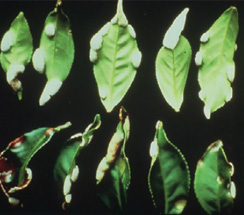Horticultural crops :: Plantation :: Tea
Blister blight: Exobasidium vexans
Symptoms
- Small, pinhole-size spots are initially seen on young leaves less than a month old.
- As the leaves develop, the spots become transparent, larger, and light brown.
- After about 7 days, the lower leaf surface develops blister-like symptoms, with dark green, water-soaked zones surrounding the blisters.
- Following release of the fungal spores, the blister becomes white and velvety.
- Subsequently the blister turns brown, and young infected stems become bent and distorted and may break off or die.
Life cycle
- The disease cycle repeats continuously during favorable(wet) conditions, and the spores are readily dispersed by wind.
- Spores that land on a leaf with adequate moisture will germinate and infect it, producing visible symptoms within 10 days.
- The fungus can directly penetrate the leaf tissue.
- The basidiospores have a low survival rate under conditions of drought or bright sunlight.
- The life cycle of the fungus is 3–4 weeks.
|
 |
| Blister blight |
|
Management
- Removal of affected leaves and shoots by pruning and destruction of the same have been recommended.
- Spraying of Bordeaux mixture or Copper Oxy Chloride 0.1%
- A mixture of 210g of Copper oxy Chloride + 210g of nickel chloride per ha sprayed at 5 days interval from June to September and October to November
- Spray Tridemorph at 340 and 560 ml/ha is satisfactory under mild and moderate rainfall conditions
Content validator:
Dr. M. Deivamani, Assistant Professor, Horticulture Research Station, Yercaud-636602.
Image source: Keith, l., Ko, W.H and Sato D.M. 2006. Identification Guide for Diseases of Tea (Camellia sinensis). Plant Disease, 33, pp-1-4.
|
|

